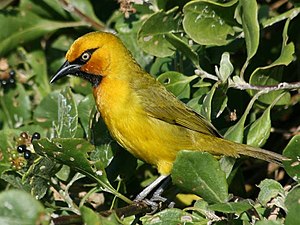Eyeglass weaver
| Eyeglass weaver | ||||||||||||
|---|---|---|---|---|---|---|---|---|---|---|---|---|

Spectacle weaver ( Ploceus ocularis ), male in KwaZulu-Natal |
||||||||||||
| Systematics | ||||||||||||
|
||||||||||||
| Scientific name | ||||||||||||
| Ploceus ocularis | ||||||||||||
| A. Smith , 1828 |
The spectacle weaver ( Ploceus ocularis ) belongs within the family of weaver birds (Ploceidae) to the genus of the bunting weaver ( Ploceus ).
The Latin additional species comes from the Latin oculus 'eye' .
The bird is found in East and Southeast Africa, in Ethiopia , Angola , Botswana , Cameroon , Kenya , Malawi , Mozambique , Namibia , Nigeria , Rwanda , Zambia , Zimbabwe , South Africa , South Sudan , Swaziland , Tanzania and Uganda .
The distribution area includes forest areas, forest edges and gardens, generally tree-lined habitats up to 2200 m altitude.
features
The species is 15 to 17 cm tall and weighs between 22 and 32 g. The male has yellowish brown on the forehead and crown, a yellow nape that merges into the golden yellow back. The male is predominantly yellow with green on the back and wing covers, a narrow black eye stripe and a wide black stripe on the throat starting from the base of the beak. The relatively slender beak is gray to anthracite. The iris is very pale yellow. The only difference between the female and the female is the missing throat strip. There is no such thing as an extra simple dress. Fledglings have paler plumage.
Geographic variation
The following subspecies are recognized:
- P. o. Crocatus ( Hartlaub , 1881) - Southeast Nigeria and East Cameroon, South Sudan, Southwest Ethiopia, Uganda, West Kenya and Tanzania, South Angola, Northeast Namibia, Botswana, Zambia and Northwest Zimbabwe. Also included is the former Ssp. P. o. Tenuirostris Traylor , 1964
- P. o. Suahelicus Neumann , 1905 - Kenya east of the Rift Valley (Kenya) , east Tanzania, Malawi, east Zambia, Zimbabwe and Mozambique
- P. o. Ocularis A. Smith , 1828, nominate form - Mozambique south of Limpopo , eastern South Africa and Swaziland. Also included is the former Ssp. P. o. Brevior Lawson , 1962
voice
The singing of the male is described as short, quick tones between the pairs "si si si" and ending with a decaying "cht".
Way of life
The diet consists mainly of insects including grasshoppers , caterpillars and beetles .
The breeding season is in December in Cameroon, in October in Ethiopia, between April and May as well as August and September in northern parts, between September and February in southern parts of the distribution area. Spectacle weavers breed alone as a couple.
Hazardous situation
The stock is not considered to be at risk ( least concern ).
Web links
- Videos, photos and sound recordings of Ploceus ocularis in the Internet Bird Collection
- Weaver Watch
Individual evidence
- ↑ Glasses weaver , in Avibase - The World Bird Database
- ^ JA Jobling: A Dictionary of Scientific Bird Names. Oxford University Press. 1991. ISBN 0-19-854634-3 .
- ↑ a b c d e Handbook of the Birds of the World
- ^ A b c T. Stevenson, J. Fanshawe: Birds of East Africa. Kenya, Tanzania, Uganda, Rwanda, and Burundi. Princeton University Press, 2002, ISBN 978-0-691-12665-4 .
- ↑ Old World sparrows, snowfinches, weavers
- ↑ a b A. JF Craig: Family Ploceidae (weavers) In: J. del Hoyo, A. Elliott & D. Christie (Eds.) Handbook of the Birds of the World, Vol. 15. Weavers to New World warblers. 2010 Lynx Edicions, Barcelona.
- ↑ Redlist
